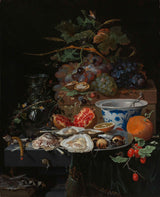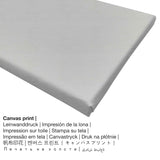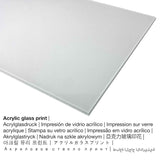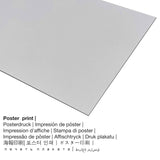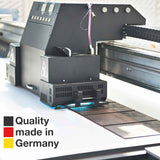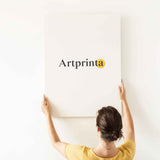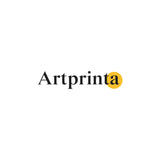Abraham Mignon, 1660 - Ndụ ka nwere mkpụrụ osisi, oysters na nnukwu efere porcelain - mbipụta nka mara mma.
Ụtụ gụnyere. Mbupu gbakọrọ na ndenye ọpụpụ.
Nkọwa ndị ọzọ site na Rijksmuseum (© Nwebiisinka - site Rijksmuseum - www.rijksmuseum.nl)
Mignon learned the rudiments of his craft from the still-life painter Jan Davidsz de Heem. The profusion of bright colours and the highly precise rendering of this still life, down to the smallest detail, betray his teacher’s influence. Mignon mastered De Heem’s tricks primarily to achieve certain effects, such as the light shining through the grapes, the glass-like shimmer of the pomegranate seeds and the water drops reflecting light.
Nkọwa na mpempe nka pụrụ iche
| Aha nka: | "Still Life with Fruit, Oysters and a Porcelain Bowl" |
| Nhazi nke ihe nka: | sere |
| Nhazi nka: | nka ochie |
| oge: | 17th narị afọ |
| Afọ nka: | 1660 |
| Afọ nka: | ihe karịrị afọ 360 |
| Egosiputara na: | Rijksmuseum |
| Ebe ngosi nka: | Amsterdam, Netherlands |
| Webụsaịtị ihe ngosi nka: | www.rijksmuseum.nl |
| Ụdị nka nka: | ngalaba ọha |
| Site n'aka: | Rijksmuseum |
Tebụl nkọwa omenkà
| Aha onye nka: | Abraham Mignon |
| A makwaara dịka: | A: Mignon, Mignonne, Mignone, Abra. Mignon, Michnion, Mingnon, Mignend Abraham, Mignioni, Mignone Abraham, Mongejongt, Mignon Abraham, A. Mignion, Mignion, Mignor Abraham, A. Minjon, Mignion Abraham, Mignor, Mignioni Abraham, A. Mingon, Minjou, Abrah. Mignon, A. Mignon, Mingon, Abraham Mignon, Ab. Mignon, Minjon, Abrh. Mignon, Mignon, Mignonne Abraham, Mignon Abrah., Mignend, Minion, Abraham Minjon, abr. mignon |
| Gender: | nwoke |
| Obodo onye nka: | German |
| Ọrụ: | onye na-ese ihe |
| Obodo obibi: | Germany |
| Nhazi nke onye nka: | nna ukwu ochie |
| Ụdị nka: | Baroque |
| Nwụrụ na afọ nke: | 49 afọ |
| Afọ ọmụmụ: | 1640 |
| Ebe omuma: | Frankfurt am Main, Hessen steeti, Germany |
| Nwụrụ n'afọ: | 1689 |
| Ebe ọnwụ: | Frankfurt am Main, Hessen steeti, Germany |
Banyere ngwaahịa
| Nkewa edemede: | ezi nka mmeputakwa |
| Usoro mmeputakwa: | dijitalụ mmeputakwa |
| Production usoro: | Mbipụta UV ozugbo (mbipụta dijitalụ) |
| Ihe ngosi: | German mmepụta |
| Stockdị ngwaahịa: | mmepụta ihe na-achọ |
| Ojiji ngwaahịa: | ihe ndozi ụlọ, mma mgbidi |
| Nhazi nka nka: | nhazi ihe osise |
| Ụdị anya: | 1: 1.2 |
| Mmetụta akụkụ onyonyo: | ogologo bụ 20% mkpụmkpụ karịa obosara |
| Nhọrọ dị: | Mbipụta iko acrylic (nke nwere ezigbo mkpuchi iko), mbipụta kanvas, mbipụta ọla (aluminium dibond), mbipụta akwụkwọ mmado (akwụkwọ kwaaji) |
| Nhọrọ nha nke akwa akwa n'elu etiti ihe na-agbatị (mbipụta kwaaji): | 50x60cm - 20x24", 100x120cm - 39x47" |
| Mbipụta iko acrylic (nwere ezigbo mkpuchi iko) nhọrọ nha: | 50x60cm - 20x24", 100x120cm - 39x47" |
| Mpempe akwụkwọ mmado (akwụkwọ kwaaji) nha dị iche iche: | 50x60cm - 20x24", 100x120cm - 39x47" |
| Nhọrọ aluminom dibond (ihe aluminom) nhọrọ: | 50x60cm - 20x24", 100x120cm - 39x47" |
| Nhazi mbipụta nka: | agunyeghi |
Ngwa ngwaahịa ndị ahịa anyị nwere ike iburu
Maka ngwaahịa ọ bụla anyị na-enye ụdị nha na ihe dị iche iche. Nha na ihe ndị a bụ nhọrọ anyị na-enye gị maka nkeonwe:
- Mbipụta nke aluminom: An Aluminium Dibond print is a print material with an outstanding depth. For your Direct Print On Aluminum Dibond, we print your favorite work of art onto the aluminium white-primed surface. The white and bright parts of the original work of art shimmer with a silk gloss, however without glow. Colors are luminous in the highest definition, the details are crisp and clear, and the print has a a matte look that you can literally feel.
- Poster (akwa akwa akwa): The poster is a UV printed flat canvas with a nice surface finish, which resembles the original version of the work of art. The poster print is perfectly qualified for placing your art copy with the help of a custom frame. Please bear in mind, that depending on the absolute size of the poster we add a white margin of around 2-6 cm round about the print motif, which facilitates the framing with a custom frame.
- Glass acrylic ebipụtara nwere mmetụta na-egbuke egbuke: An print on acrylic glass, which is sometimes described as a print on plexiglass, will change the artwork into beautiful décor. Your favorite work of art is printed with modern UV printing technology.
- Kwaaji: The UV printed canvas material stretched on a wooden frame. It creates the special effect of three-dimensionality. The advantage of canvas prints is that they are relatively low in weight, which implies that it is easy and straightforward to hang up the Canvas print without any wall-mounts. That is why, canvas prints are suited for all types of walls.
Nkọwapụta ngwaahịa ebipụta
This piece of art named "Still Life with Fruit, Oysters and a Porcelain Bowl" was made by the Baroque artist Abraham Mignon in 1660. The artwork belongs to the Rijksmuseum's mkpokọta nka, nke bụ ihe ngosi nka kacha ukwuu maka nka na akụkọ Dutch site na Middle Ages ruo ugbu a. Site n'ikike nke Rijksmuseum (licensed: public domain).Creditline of the artwork: . The alignment is portrait with a ratio of 1: 1.2, which implies that the length is 20% shorter than the width. The painter Abraham Mignon was an artist, whose style was primarily Baroque. The Baroque artist lived for 49 afọ - born in the year 1640 in Frankfurt am Main, Hessen state, Germany and deceased in the year 1689.
Ozi dị mkpa: We try whatever we can to depict the products as accurately as possible and to exhibit them visually. Nonetheless, the pigments of the printed materials, as well as the printing might vary to a certain extent from the image on the monitor. Depending on the settings of your screen and the quality of the surface, color pigments might not be printed one hundret percent realistically. Considering that all our art reproductions are processed and printed by hand, there may also be slight variations in the exact position and the size of the motif.
© Nchekwa ikike nwebisiinka | Artprinta.com (Artprinta)

